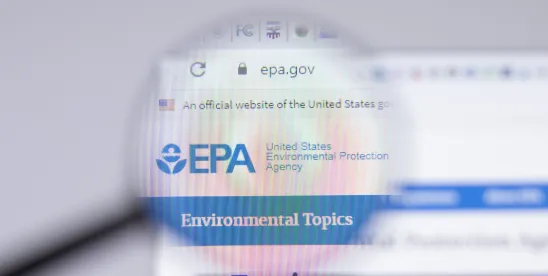On August 1, 2023, Earthjustice filed a petition under Section 21 of the Toxic Substances Control Act (TSCA) asking the U.S. Environmental Protection Agency (EPA) to establish regulations prohibiting the manufacturing, processing, use, and distribution of the chemical N-(1,3-Dimethylbutyl)-N′-phenyl-p-phenylenediamine (6PPD) for and in tires. Earthjustice filed the petition on behalf of the Yurok Tribe, the Port Gamble S’Klallam Tribe, and the Puyallup Tribe of Indians, and EPA granted the petition in November 2023. On November 14, 2024, EPA released an advance notice of proposed rulemaking (ANPRM) to solicit and collect information from the public on the potential risks associated with 6PPD and its transformation product, 6PPD-quinone. EPA also seeks information about potential alternatives and regulatory options to help inform its consideration of potential future regulatory actions under TSCA. Comments will be due 60 days after publication in the Federal Register. EPA has posted a pre-publication version of the ANPRM.
EPA seeks public comment on all information included or referenced in the ANPRM and also seeks any other information relevant to 6PPD and/or 6PPD-quinone. EPA states that it is “particularly interested” in receiving quantitative information, data, and/or case examples (e.g., peer-reviewed studies and industry scientific and technical reports describing data sets and/or syntheses of environmental and human health impacts that include statistical analyses) addressing the following topics:
- Environmental effects of 6PPD and/or 6PPD-quinone on aquatic ecosystems;
- Environmental effects of 6PPD and/or 6PPD-quinone on terrestrial ecosystems;
- Potential human health and Tribal effects of 6PPD and/or 6PPD-quinone;
- 6PPD’s use in tires, releases of 6PPD and/or 6PPD-quinone into the environment, and remediation technologies; and
- The alternatives to 6PPD’s use in tires.
EPA is gathering information on a potential rulemaking. EPA requests comment on:
- If the Agency moves forward with a proposed rule after the ANPRM is published, what potential actions could EPA take under TSCA Section 6(a)? Potential options include:
- Regulate the manufacturing, processing, or distribution in commerce of the chemical, including a complete ban of any such activity or limiting the amounts of the chemical manufactured, distributed, and/or included in tires;
- Regulate the manufacturing, processing, or distribution in commerce of the chemical for particular uses, including banning any such activity for a particular use; limiting the concentration of the chemical that may be used; or limiting the amounts of the chemical for particular uses;
- Require warning statements and/or instructions for use with respect to the chemical’s use in tires and non-tire materials (e.g., rubber modified asphalt, sneakers, elastics), distribution in commerce, and/or disposal of the chemical or products containing the chemical;
- Require manufacturers/processors to make and retain such records of the manufacturing process and/or monitor or conduct tests to ensure compliance with a TSCA Section 6 rule;
- Prohibit or regulate any manner or method of commercial use of the chemical;
- Prohibit or regulate the disposal of the chemical; and
- Require manufacturers/processors to provide warnings to distributors or users and to replace or repurchase the chemical.
- Regulate the manufacturing, processing, or distribution in commerce of the chemical, including a complete ban of any such activity or limiting the amounts of the chemical manufactured, distributed, and/or included in tires;
- EPA notes that TSCA provides it the authority to select a combination of TSCA Section 6(a) actions and limit the geographic application of a rule under TSCA Section 6(a). EPA requests comment on whether, and if so, where EPA should consider limits to the geographical scope of any potential action under TSCA Section 6(a).
- EPA states that TSCA Section 9 provides that the EPA Administrator shall consult and coordinate with the heads of other appropriate federal executive departments or agencies to achieve maximum enforcement of TSCA, while imposing the least burden of duplicative requirements. EPA notes that the Administrator is also directed to coordinate actions taken under TSCA with actions taken under other federal laws administered by EPA, such as the Resource Conservation and Recovery Act (RCRA), the Clean Air Act (CAA), and the Clean Water Act (CWA). EPA asks if there are other statutory authorities that it administers that could be used to eliminate or reduce to a sufficient extent any risk identified.
- EPA notes that TSCA Section 6(g) allows it to grant an exemption from a requirement of a TSCA Section 6(a) rule for a specific condition of use of a chemical substance or mixture, if the Administrator finds that: the specific condition of use is a critical or essential use for which no technically and economically feasible safer alternative is available; compliance with the requirement, as applied with respect to the specific condition of use, would significantly disrupt the national economy, national security, or critical infrastructure; or the specific condition of use of the chemical substance or mixture, as compared to reasonably available alternatives, provides a substantial benefit to health, the environment, or public safety. EPA asks what it should consider regarding a potential TSCA Section 6(g) exemption for 6PPD use in tires and what conditions may be necessary to protect health and the environment while achieving the purposes of an exemption.
Commentary
We have reported in other contexts on the growing use of TSCA Section 21 petitions to influence EPA’s regulatory agenda. This initiative is another case in point. EPA is wise to seek public comment as its risk evaluation of 6PPD will present a significant challenge to EPA. There are environmental concerns for 6PPD that must be balanced against its use in tires to prevent early failure of tires, a use critical for economic and driver safety reasons. Extending the use lifetime of tires (by inhibiting oxidation) also reduces the need to replace tires, thereby reducing the need to manage waste tires — a significant issue. It is unclear whether there is a replacement for 6PPD that performs the necessary function without a similar hazard profile as 6PPD. Tire manufacturers have been working with the California Safer Consumer Products program and Washington State Department of Ecology to identify alternatives, but identifying an alternative and proving its utility and safety in tires will take time. Until such an alternative exists, EPA may be in a difficult position where the only control measure that satisfies the “extent necessary” to protect against risk identified is to ban 6PPD, yet without a safer alternative that is also available in the necessary volumes, such a ban is untenable. It is also unclear what risk management action EPA will take if EPA finds that 6PPD in waste tires also presents an unreasonable risk. There are limited options for waste tires. One of those options is pyrolysis, a process with which EPA and others have expressed concern.
The 6PPD risk evaluation and risk management actions will be an important case study for EPA’s implementation of TSCA Section 6. We encourage stakeholders to stay tuned and participate in the process.





 />i
/>i
